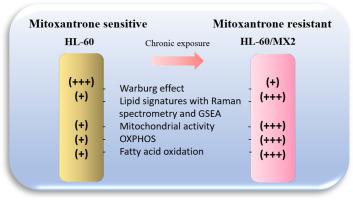Biochimica et Biophysica Acta (BBA) - Bioenergetics ( IF 4.3 ) Pub Date : 2020-08-25 , DOI: 10.1016/j.bbabio.2020.148300 Sameer Salunkhe 1 , Saket V Mishra 1 , Atanu Ghorai 2 , Aarti Hole 3 , Pratik Chandrani 4 , Amit Dutt 5 , Murali Chilakapati 6 , Shilpee Dutt 1

|
Alteration in metabolic repertoire is associated with resistance phenotype. Although a common phenotype, not much efforts have been undertaken to design effective strategies to target the metabolic drift in cancerous cells with drug resistant properties. Here, we identified that drug resistant AML cell line HL-60/MX2 did not follow classical Warburg effect, instead these cells exhibited drastically low levels of aerobic glycolysis. Biochemical analysis confirmed reduced glucose consumption and lactic acid production by resistant population with no differences in glutamine consumption. Raman spectroscopy revealed increased lipid and cytochrome content in resistant cells which were also visualized as lipid droplets by Raman mapping, electron microscopy and lipid specific staining. Gene set enrichment analysis data from sensitive and resistant cell lines revealed significant enrichment of lipid metabolic pathways in HL-60/MX2 cells. Further, HL-60/MX2 possessed higher mitochondrial activity and increased OXPHOS suggesting the role of fatty acid metabolism as energy source which was confirmed by increased rate of fatty acid oxidation. Accordingly, OXPHOS inhibitor increased sensitivity of resistant cells to chemotherapeutic drug and fatty acid oxidation inhibitor Etomoxir reduced colony formation ability of resistant cells demonstrating the requirement of fatty acid metabolism and dependency on OXPHOS by resistant leukemic cells for survival and tumorigenicity.
中文翻译:

耐药细胞中的代谢重新连接表现出较高的OXPHOS和脂肪酸,是细胞能量学的首选主要来源。
代谢库的改变与抗性表型有关。尽管是常见的表型,但并未进行太多努力来设计有效的策略来靶向具有耐药性的癌细胞的代谢漂移。在这里,我们确定了耐药性AML细胞系HL-60 / MX2没有遵循经典的Warburg效应,而是这些细胞表现出了极低的需氧糖酵解水平。生化分析证实,耐药人群的葡萄糖消耗和乳酸生产减少,而谷氨酰胺消耗没有差异。拉曼光谱显示抗性细胞中脂质和细胞色素的含量增加,这也可以通过拉曼作图,电子显微镜和脂质特异性染色将其显示为脂质滴。来自敏感和抗性细胞系的基因集富集分析数据显示,HL-60 / MX2细胞中脂质代谢途径显着富集。此外,HL-60 / MX2具有更高的线粒体活性和增加的OXPHOS,表明脂肪酸代谢作为能源的作用,这可以通过脂肪酸氧化速率的增加得到证实。因此,OXPHOS抑制剂增加了耐药细胞对化学治疗药物的敏感性,而脂肪酸氧化抑制剂Etomoxir降低了耐药细胞的集落形成能力,这证明了脂肪酸代谢的需要以及耐药白血病细胞对OXPHOS的依赖以维持生存和致瘤性。HL-60 / MX2具有更高的线粒体活性和增加的OXPHOS,表明脂肪酸代谢作为能源的作用已被脂肪酸氧化速率增加所证实。因此,OXPHOS抑制剂增加了耐药细胞对化学治疗药物的敏感性,而脂肪酸氧化抑制剂Etomoxir降低了耐药细胞的集落形成能力,这证明了脂肪酸代谢的需要以及耐药白血病细胞对OXPHOS的依赖以维持生存和致瘤性。HL-60 / MX2具有更高的线粒体活性和增加的OXPHOS,表明脂肪酸代谢作为能源的作用已被脂肪酸氧化速率增加所证实。因此,OXPHOS抑制剂增加了耐药细胞对化学治疗药物的敏感性,而脂肪酸氧化抑制剂Etomoxir降低了耐药细胞的集落形成能力,这证明了脂肪酸代谢的需要以及耐药白血病细胞对OXPHOS的依赖以维持生存和致瘤性。



























 京公网安备 11010802027423号
京公网安备 11010802027423号